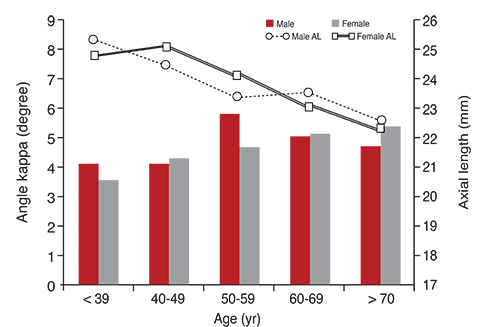Korean J Ophthalmol.
2013 Dec;27(6):421-424. 10.3341/kjo.2013.27.6.421.
The Correlation between Angle Kappa and Ocular Biometry in Koreans
- Affiliations
-
- 1Department of Ophthalmology, Kim's Eye Hospital, Seoul, Korea. ungsookim@kimeye.com
- 2Department of Ophthalmology, Konyang University College of Medicine, Daejeon, Korea.
- KMID: 1792077
- DOI: http://doi.org/10.3341/kjo.2013.27.6.421
Abstract
- PURPOSE
To investigate normative angle kappa data and to examine whether correlations exist between angle kappa and ocular biometric measurements (e.g., refractive error, axial length) and demographic features in Koreans.
METHODS
Data from 436 eyes (213 males and 223 females) were analyzed in this study. The angle kappa was measured using Orbscan II. We used ocular biometric measurements, including refractive spherical equivalent, interpupillary distance and axial length, to investigate the correlations between angle kappa and ocular biometry. The IOL Master ver. 5.02 was used to obtain axial length.
RESULTS
The mean patient age was 57.5 +/- 12.0 years in males and 59.4 +/- 12.4 years in females (p = 0.11). Angle kappa averaged 4.70 +/- 2.70 degrees in men and 4.89 +/- 2.14 degrees in women (p = 0.48). Axial length and spherical equivalent were correlated with angle kappa (r = -0.342 and r = 0.197, respectively). The correlation between axial length and spherical equivalent had a negative correlation (r = -0.540, p < 0.001).
CONCLUSIONS
Angle kappa increased with spherical equivalent and age. Thus, careful manipulation should be considered in older and hyperopic patients when planning refractive or strabismus surgery.
Keyword
MeSH Terms
Figure
Cited by 1 articles
-
Measurement of Angle Lambda Using Pentacam in Normal and Exotropic Children
Young Je Sung, Sang Min Nam, Helen Lew
J Korean Ophthalmol Soc. 2015;56(8):1263-1267. doi: 10.3341/jkos.2015.56.8.1263.
Reference
-
1. Hashemi H, KhabazKhoob M, Yazdani K, et al. Distribution of angle kappa measurements with Orbscan II in a population-based survey. J Refract Surg. 2010; 26:966–971.2. Von Noorden GK, Campos EC. Binocular vision and ocular motility: theory and management of strabismus. 6th ed. St. Louis: Mosby;2002. p. 169–173.3. Stone N, Weir CR. Beware angle kappa: an unusual problem following strabismus surgery. Strabismus. 2009; 17:165–166.4. Basmak H, Sahin A, Yildirim N, et al. Measurement of angle kappa with synoptophore and Orbscan II in a normal population. J Refract Surg. 2007; 23:456–460.5. Basmak H, Sahin A, Yildirim N, et al. The angle kappa in strabismic individuals. Strabismus. 2007; 15:193–196.6. Blake CR, Lai WW, Edward DP. Racial and ethnic differences in ocular anatomy. Int Ophthalmol Clin. 2003; 43:9–25.7. Barretto RL, Mathog RH. Orbital measurement in black and white populations. Laryngoscope. 1999; 109(7 Pt 1):1051–1054.8. Au Eong KG, Tay TH, Lim MK. Race, culture and Myopia in 110,236 young Singaporean males. Singapore Med J. 1993; 34:29–32.9. McMahon TT, Irving EL, Lee C. Accuracy and repeatability of self-measurement of interpupillary distance. Optom Vis Sci. 2012; 89:901–907.10. Kahn DM, Shaw RB Jr. Aging of the bony orbit: a three-dimensional computed tomographic study. Aesthet Surg J. 2008; 28:258–264.11. Giovanni F, Siracusano B, Cusmano R. The angle kappa in ametropia. New Trends Ophthalmol. 1988; 3:27–33.12. Lam CS, Goh WS. The incidence of refractive errors among school children in Hong Kong and its relationship with the optical components. Clin Exp Optom. 1991; 74:97–103.
- Full Text Links
- Actions
-
Cited
- CITED
-
- Close
- Share
- Similar articles
-
- The Angle Kappa in Dominant and Non-Dominant Eye
- Angle Kappa Measurement with Slit Lamp Biomicroscope
- Comparison of Hirschberg Test with Prsim and Alternate Cover Test in Measuring the Ocular Deviation
- Comparison of Ocular Biometry Measurements Using A-Scan Ultrasound and Two Types of Partial Coherence Interferometers
- Measurement of Angle Kappa Using Ultrasound Biomicroscopy and Corneal Topography



